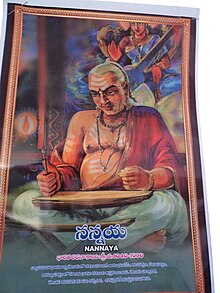Nannayya
This article needs additional citations for verification. (July 2015) |
- This article is about the Telugu author; for the Mesopotamian goddess see Nanaya.
Nannaya Bhattaraka | |
|---|---|
| Native name | నన్నయ |
| Born | Nannyya Rajahmundry |
| Died | Rajahmundry, Andhra Pradesh |
| Pen name | Nannaya |
| Occupation | First Telugu Translator |
| Nationality | Indian |
| Period | Eleventh century |
| Genre | Poet |
| Literary movement | Bhakti movement |
| Notable works | Andhra Mahabharatam |

Nannaya Bhattaraka (sometimes spelled Nannayya or Nannaiah; ca. 11th century AD) is the earliest known Telugu author, and the author of the first third of the Andhra mahabharatam, a Telugu retelling of the Mahabharata. Nannaya is held in high regard as the person who revived the Telugu language. This work, which is rendered in the Champu style, is chaste and polished and of a high literary merit.
The first treatise on Telugu grammar, the "Andhra Shabda Chintamani", was written in Sanskrit by Nannaya, who was considered first poet and translator of Telugu in the 11th century A.D. There was no grammatical work in Telugu prior to it. This grammar followed the patterns which existed in grammatical treatises like Aṣṭādhyāyī and Vālmīkivyākaranam but unlike Pāṇini, Nannaya divided his work into five chapters, covering samjnā, sandhi, ajanta, halanta and kriya.[1]
He is also known as Adi Kavi in recognition of his great literary work. He also holds the titles Shabda Sasanudu and Vaganu Sasanudu (Law giver of the language) after his Telugu grammar work Andhra Shabdha Chintamani.[citation needed]
The advanced and well-developed language used by Nannaya suggests that Nannaya Mahabharatamu may not be the beginning of Telugu literature. Unfortunately, no Telugu literature prior to Nannaya is available, except royal grants and decrees, though Telugu language started to develop even before the Common Era.
Political reason
Pulakesin II (609–642) of Chalukya Dynasty, the ruler of Vatapi (Badami of Karnataka) conquered Vengi (Andhra) and sent Kubja Vishnuvardhana, his brother, as viceroy for the Vengi region. Later in 634 AD, Vishnuvardhana declared himself independent and established Eastern Chalukya Dynasty in Andhra Pradesh that lasted for five centuries. Rajaraja Narendra of Eastern Chalukya Dynasty ascended to the throne in 1022 AD. At the time of Rajaraja Narendra, two literary works in Kannada language, viz., Vikramarjuna Vijaya and Gadayudda already popularized the story of Sanskrit Mahabharata in Karnataka. Kannada translations of Mahabharata were available by the Seventh and Eighth centuries. But, Puranaas were not available in Telugu. Brahmins used to recite Puranaas such as Sanskrit Mahabharata in Temples and courts.
Eastern Chalukya Dynasty supported Jainism and Shaivism (Veera Shaivism). Rajaraja Narendra was a Shaivite. He respected Brahmins, and went on patroinizing Shaivism and Sanskrit language. He learned from the success of Jains and Buddhists that the only way to popularize the new religions and Puranaas was to translate them into Telugu. Even a thousand years before, Buddhism and Jainism became very popular using local languages for their sermons and teachings. So, Rajaraja Narendra requested his teacher, adviser and court poet Nannaya Bhattaraka to translate Sanskrit Mahabharata into Telugu for his subjects.
Nannaya Bhattaraka took the challenge very seriously. He scrutinized all the Telugu vocabulary that was in usage at that time, introduced Sanskrit vocabulary, and took characteristics of already well developed Kannada literature. Thus he developed a distinct literary style, meter and grammar. Nannaya translated about 142 verses of Aadi, Sabha and Aranya chapters of Sanskrit Mahabharata. But, he didn't stick to the original. He almost created his own version of Andhra Mahabharatamu by modification, addition and deletion, while maintaining the story line.
It took 300 more years and two more writers, Thikkana and Errana, to complete the work started by Nannaya. Nannaya died while working on the 3rd (aranya parvam) and it was rumored subsequently that it is inauspicious (leading to immediate death) to touch on that episode. So Tikkanna who undertook the completion of this great work, started the work from chapter 4. Yerrapragada, later completed the half portion of the 3rd chapter and lived a full life. This period was known as period of translations, because during this period various Sanskrit texts and Puranaas were translated into Telugu by scholars. This resulted in a very long lasting impact of Sanskrit on Telugu language and literature and the beginning of a new era in the history of Telugu literature. Nannaya was the first to translate a Sanskrit text into Telugu language and he rightly holds the titles Aadi Kavi (the First Poet) and Vaaganusaasanudu (the dictator of the language).
See also
References
- ^ Gopavaram, Padmapriya; Subrahmanyam, Korada (2011). "1". A Comparative Study Of Andhrasabdachintamani And Balavyakaranam. Hyderabad: University of Hyderabad.
Notes
- History and Culture of Andhra Pradesh, P. R. Rao
- Andhrula Saanghika Charitra, Pratapareddy Suravaram
- Andhra Vagmaya Charitramu, Dr. Venkatavadhani Divakarla
- Andhra Pradesh Darshini, Parts 1 and 2, Chief Editor Y. V. Krishnarao
